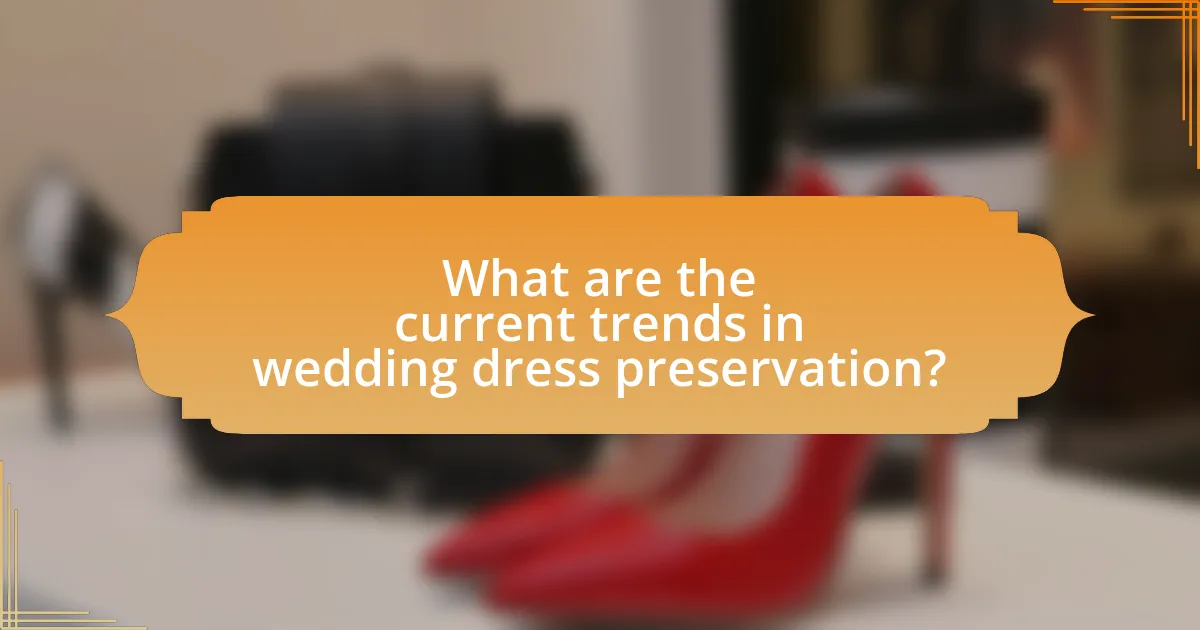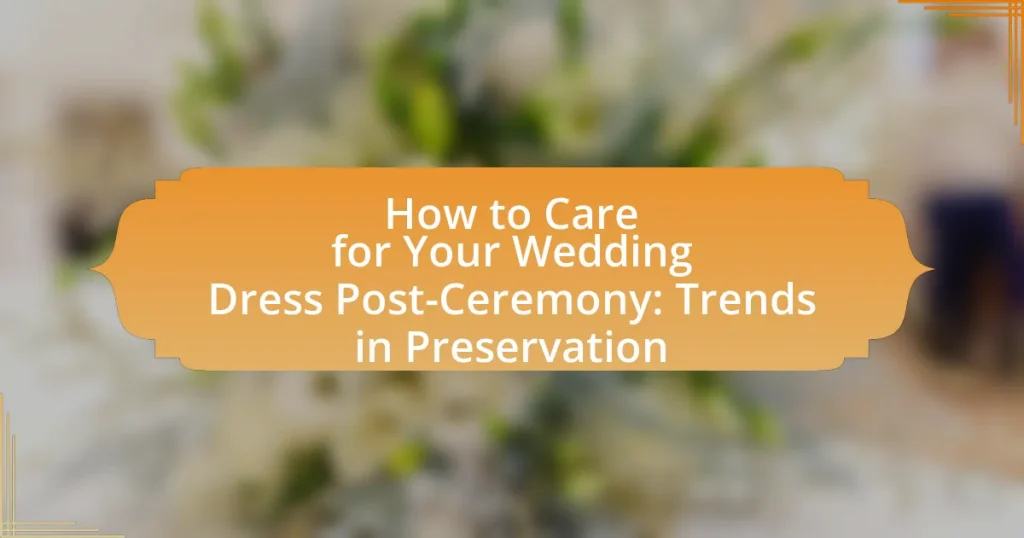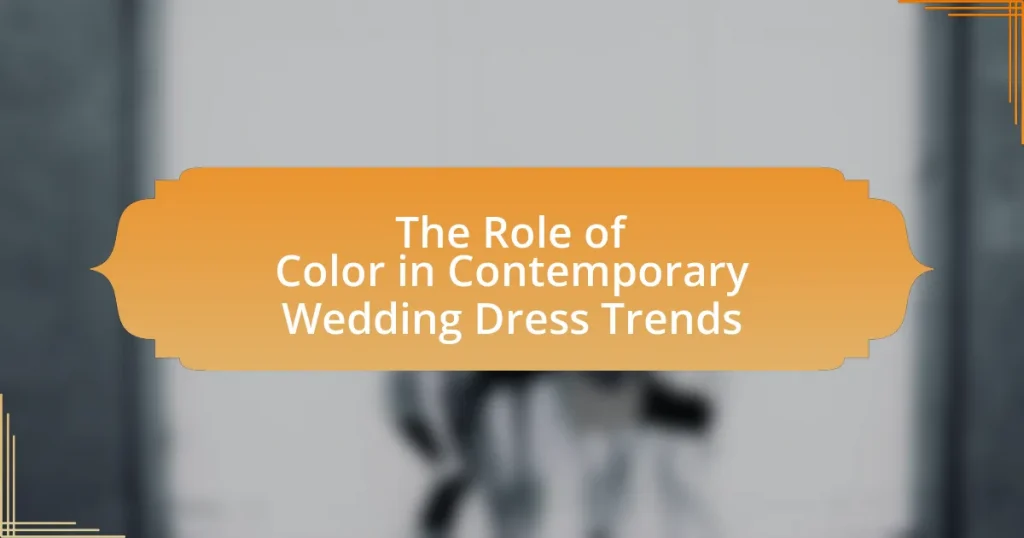The article focuses on the essential care and preservation of wedding dresses immediately after the ceremony. It outlines the proper steps for storing and cleaning the dress to prevent damage, including the importance of using breathable materials and avoiding direct sunlight. The article also discusses common stains, modern preservation techniques, and the significance of timely cleaning to maintain the dress’s condition. Additionally, it highlights current trends in wedding dress preservation, such as eco-friendly methods and advancements in preservation technology, providing a comprehensive guide for brides looking to protect their cherished garments.

How should you care for your wedding dress immediately after the ceremony?
To care for your wedding dress immediately after the ceremony, gently hang it in a cool, dry place away from direct sunlight to prevent any fabric damage. This method helps to preserve the dress’s shape and color, as exposure to heat and light can lead to fading and deterioration. Additionally, avoid placing the dress on a rough surface to prevent snagging or tearing. According to textile preservation experts, proper immediate care can significantly extend the life of delicate fabrics, ensuring that the dress remains in pristine condition for future use or display.
What are the first steps to take after the wedding?
The first steps to take after the wedding include properly storing the wedding dress and arranging for its cleaning and preservation. Immediately after the ceremony, the dress should be hung in a cool, dry place to avoid wrinkles and damage. It is essential to consult a professional cleaner who specializes in wedding dress preservation, as they can use techniques that prevent yellowing and fabric deterioration. According to the Association of Wedding Gown Specialists, timely cleaning within six weeks post-wedding significantly increases the chances of maintaining the dress’s original condition.
How do you properly store your wedding dress right after the event?
To properly store your wedding dress right after the event, first, gently clean any stains with a soft cloth and cold water. This step is crucial as it prevents stains from setting in. Next, place the dress in a breathable garment bag made of cotton or muslin to protect it from dust and light. Avoid plastic bags, as they can trap moisture and lead to mildew. Store the dress in a cool, dry place away from direct sunlight to prevent fading and fabric degradation. This method is supported by preservation experts who recommend these practices to maintain the integrity of delicate fabrics over time.
What precautions should you take to avoid damage during transport?
To avoid damage during transport, securely package the wedding dress in a breathable garment bag or box. This method protects the fabric from dust, moisture, and physical abrasion. Additionally, use acid-free tissue paper to cushion the dress and prevent creasing. Properly securing the dress within the packaging minimizes movement, reducing the risk of tears or other damage. Transport the dress in a climate-controlled environment to avoid exposure to extreme temperatures or humidity, which can harm delicate fabrics.
Why is it important to clean your wedding dress promptly?
Cleaning your wedding dress promptly is crucial to prevent stains from setting and to maintain its condition. Stains from food, drink, or even natural body oils can become permanent if not addressed quickly, leading to irreversible damage. According to the Association of Wedding Gown Specialists, timely cleaning within 24 to 48 hours can significantly reduce the risk of discoloration and fabric deterioration, ensuring that the dress remains in pristine condition for future use or preservation.
What types of stains are most common on wedding dresses?
The most common stains on wedding dresses include food and beverage stains, dirt and grass stains, and makeup smudges. Food and beverage stains often occur during the reception, with red wine and cake being frequent culprits. Dirt and grass stains typically result from outdoor ceremonies or receptions, while makeup smudges can happen during application or when hugging guests. These stains are prevalent due to the nature of wedding celebrations, where dresses are exposed to various substances and environments.
How can immediate cleaning prevent long-term damage?
Immediate cleaning can prevent long-term damage to a wedding dress by removing stains and contaminants before they set in. Stains from food, drink, or bodily fluids can become permanent if not addressed quickly, leading to discoloration and fabric degradation. For example, a study by the Textile Research Journal indicates that untreated stains can cause irreversible changes in fabric structure within 24 hours. By promptly cleaning the dress, the integrity of the fabric is maintained, ensuring that it remains in pristine condition for future use or preservation.

What are the current trends in wedding dress preservation?
Current trends in wedding dress preservation include the use of eco-friendly preservation methods, such as biodegradable materials and non-toxic cleaning agents. Many couples are opting for preservation services that utilize archival-quality boxes and acid-free tissue to prevent yellowing and damage over time. Additionally, there is a growing interest in digital preservation, where high-resolution photographs and 3D scans of the dress are created for virtual keepsakes. These trends reflect a shift towards sustainability and technology in preserving cherished wedding attire.
How have preservation techniques evolved in recent years?
Preservation techniques for wedding dresses have evolved significantly in recent years, primarily through advancements in technology and materials. Modern preservation methods now utilize acid-free tissue paper and archival-quality boxes to prevent yellowing and deterioration, which contrasts with older techniques that often involved plastic storage that could trap moisture and lead to damage. Additionally, the introduction of specialized cleaning agents that are gentle yet effective has improved the cleaning process, ensuring that delicate fabrics are not harmed. Research indicates that these updated methods can extend the lifespan of wedding dresses by up to 50 years, demonstrating their effectiveness in maintaining the garment’s integrity over time.
What modern methods are available for preserving wedding dresses?
Modern methods for preserving wedding dresses include professional cleaning and archival storage, vacuum sealing, and the use of acid-free materials. Professional cleaning involves specialized techniques to remove stains and prevent fabric degradation, ensuring the dress remains in pristine condition. Archival storage utilizes breathable garment bags and acid-free boxes to protect the dress from light, dust, and humidity, which can cause yellowing and deterioration. Vacuum sealing removes air and moisture, further safeguarding the fabric from environmental damage. These methods are supported by textile conservation practices that emphasize the importance of proper care to maintain the integrity and appearance of delicate fabrics over time.
How do these methods compare to traditional preservation techniques?
These methods, such as modern archival techniques and specialized cleaning processes, offer advantages over traditional preservation techniques by providing enhanced protection against environmental factors and physical deterioration. Traditional methods often rely on basic storage and cleaning, which may not adequately prevent yellowing, fabric degradation, or mold growth. In contrast, modern preservation techniques utilize acid-free materials and controlled environments, significantly reducing the risk of damage. For instance, studies have shown that garments stored in acid-free boxes experience less discoloration compared to those stored in standard materials, highlighting the effectiveness of contemporary approaches in maintaining the integrity of wedding dresses over time.
What materials are commonly used in wedding dress preservation?
Common materials used in wedding dress preservation include acid-free tissue paper, muslin, and archival boxes. Acid-free tissue paper is utilized to prevent yellowing and damage to delicate fabrics, while muslin serves as a breathable layer that protects the dress from dust and moisture. Archival boxes are designed to provide a safe, acid-free environment for long-term storage, ensuring that the dress remains in pristine condition. These materials are specifically chosen for their ability to minimize deterioration and maintain the integrity of the wedding dress over time.
Why is acid-free tissue important in the preservation process?
Acid-free tissue is crucial in the preservation process because it prevents the degradation of delicate fabrics over time. Unlike regular tissue, which contains acids that can cause yellowing, brittleness, and deterioration, acid-free tissue is specifically designed to be pH neutral, ensuring that it does not react negatively with the materials of the wedding dress. This quality is essential for maintaining the integrity and appearance of the fabric, as studies have shown that acidic environments can lead to irreversible damage in textiles. Therefore, using acid-free tissue is a fundamental practice in preserving wedding dresses and other delicate garments.
How do different fabrics affect preservation choices?
Different fabrics significantly influence preservation choices for wedding dresses due to their varying properties and susceptibility to damage. For instance, silk is delicate and prone to yellowing and water stains, necessitating careful handling and specialized cleaning methods to maintain its integrity. Conversely, polyester is more durable and resistant to wrinkles and stains, allowing for simpler preservation techniques. Additionally, fabrics like lace and tulle require specific storage conditions to prevent snagging and deformation, which can affect the overall appearance of the dress over time. Therefore, understanding the characteristics of each fabric type is crucial for selecting appropriate preservation methods that ensure the longevity and aesthetic quality of the wedding dress.

What should you consider when choosing a preservation service?
When choosing a preservation service for your wedding dress, consider the service’s reputation, expertise in fabric care, and the preservation methods used. A reputable service often has positive reviews and testimonials, indicating reliability and quality. Expertise in fabric care is crucial, as different materials require specific handling to prevent damage. Additionally, the preservation methods should include acid-free materials and proper storage techniques to ensure long-term protection against yellowing and deterioration. These factors collectively ensure that your wedding dress remains in pristine condition for years to come.
How do you evaluate the quality of a preservation service?
To evaluate the quality of a preservation service, assess their experience, methods, and customer reviews. A reputable service should have a proven track record, ideally with several years in the industry, demonstrating expertise in fabric care and preservation techniques. Additionally, the use of archival-quality materials and processes, such as acid-free boxes and UV-protective storage, is essential for long-term preservation. Customer reviews and testimonials provide insight into the satisfaction of previous clients, highlighting the service’s reliability and effectiveness. Services that offer guarantees or warranties on their preservation work further indicate confidence in their quality.
What certifications should you look for in a preservationist?
Look for certifications such as the Certified Textile Conservator (CTC) and the American Institute for Conservation (AIC) membership when selecting a preservationist. These certifications indicate that the preservationist has undergone rigorous training and adheres to professional standards in textile conservation. The CTC certification specifically requires a demonstrated level of expertise in the care and preservation of textiles, while AIC membership signifies a commitment to ethical practices and ongoing education in conservation.
How can customer reviews influence your choice of service?
Customer reviews significantly influence your choice of service by providing insights into the experiences of previous clients. These reviews often highlight the quality of service, reliability, and customer satisfaction, which can guide potential customers in making informed decisions. For instance, a study by BrightLocal in 2022 found that 87% of consumers read online reviews for local businesses, indicating that positive feedback can enhance trust and credibility. Conversely, negative reviews can deter customers, as 94% of respondents in the same study stated that a negative review has convinced them to avoid a business. Therefore, customer reviews serve as a critical factor in evaluating service options, particularly in specialized areas like wedding dress preservation, where trust and expertise are paramount.
What are the costs associated with wedding dress preservation?
The costs associated with wedding dress preservation typically range from $150 to $600. This price variation depends on factors such as the type of preservation method used, the complexity of the dress, and the service provider’s reputation. For instance, traditional preservation methods, which often include cleaning, boxing, and acid-free materials, generally fall within the lower end of this range, while more specialized services, such as those involving intricate beading or delicate fabrics, can reach the higher end. Additionally, some preservation services may offer guarantees or insurance, which can also influence the overall cost.
How do preservation costs vary based on dress materials and services?
Preservation costs vary significantly based on dress materials and services, with natural fabrics like silk and lace typically incurring higher costs due to their delicate nature and specific care requirements. For instance, silk wedding dresses often require specialized cleaning and preservation techniques to prevent damage, leading to costs ranging from $200 to $600. In contrast, synthetic materials like polyester may have lower preservation costs, often between $100 and $300, as they are more durable and easier to clean. Additionally, the choice of preservation service impacts costs; services that include archival-quality boxes and acid-free materials for storage can increase expenses, while basic cleaning and packaging options are more economical.
What factors can affect the overall price of preservation?
The overall price of preservation can be affected by factors such as the type of preservation method used, the condition of the wedding dress, and the geographical location of the preservation service. Different preservation methods, such as acid-free storage or specialized cleaning techniques, vary in cost due to the materials and expertise required. The condition of the dress, including stains or damage, can increase the price as additional cleaning or repairs may be necessary. Additionally, geographical location influences pricing, as services in urban areas may charge more due to higher operational costs compared to rural areas.
What are some best practices for maintaining your wedding dress post-preservation?
To maintain your wedding dress post-preservation, store it in a cool, dry place away from direct sunlight. This prevents discoloration and fabric degradation. Additionally, keep the dress in a breathable garment bag made of cotton or muslin to protect it from dust and moisture while allowing air circulation. Regularly check the dress for any signs of damage or deterioration, such as yellowing or fabric weakening, and address these issues promptly to prevent further damage. According to preservation experts, these practices significantly extend the life of the dress and maintain its original beauty.
How often should you check on your preserved wedding dress?
You should check on your preserved wedding dress every six months. Regular inspections help ensure that the preservation methods remain effective and that no damage, such as discoloration or mold, occurs over time. This frequency is recommended by preservation experts who emphasize that monitoring the condition of the dress can prevent long-term deterioration and maintain its quality for years to come.
What storage conditions are ideal for a preserved wedding dress?
The ideal storage conditions for a preserved wedding dress include a cool, dark, and dry environment. Maintaining a temperature between 60-70°F (15-21°C) and a humidity level of around 40-50% helps prevent mold and fabric deterioration. Storing the dress in an acid-free box or a breathable garment bag protects it from light exposure and dust. Additionally, avoiding plastic covers is crucial, as they can trap moisture and lead to yellowing or damage over time. These conditions are supported by textile preservation guidelines from institutions like the American Institute for Conservation, which emphasize the importance of environmental control in fabric care.



